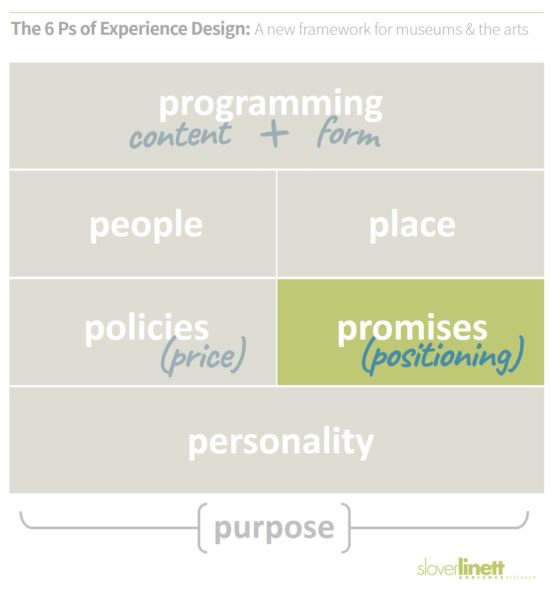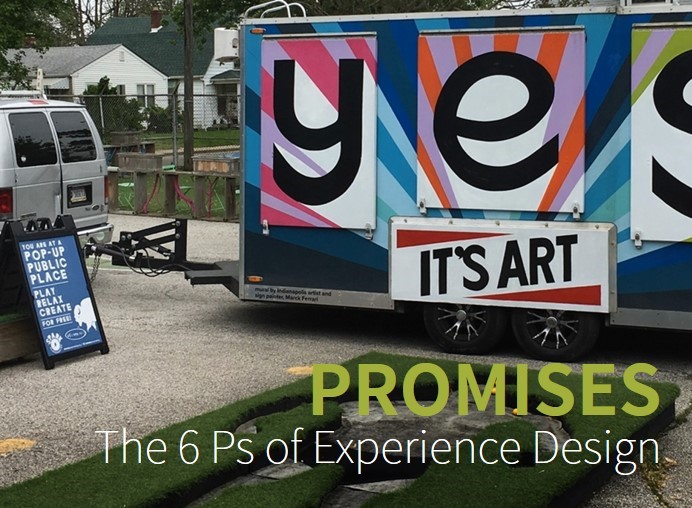News & Notes
Promises & positioning (6 Ps of Experience Design)
This is the seventh in a series of posts about our new framework for cultural engagement, The 6 Ps of Experience Design. If you haven’t read the preceding posts, you may want to start at the beginning.
- Policies
- Promises [this post]
- Personality
- Bonus “P”: Purpose
Is marketing part of the cultural experience? From the audience member or participant’s point of view, yes.
 The promises your organization makes in its branding and communications — visual and verbal, print and electronic, explicit and implicit — do more than get people in the door (or not). They are the earliest stage of the experience for most people, setting their expectations, framing the possibilities, and beginning to understand and connect with both the form and content of the programming.
The promises your organization makes in its branding and communications — visual and verbal, print and electronic, explicit and implicit — do more than get people in the door (or not). They are the earliest stage of the experience for most people, setting their expectations, framing the possibilities, and beginning to understand and connect with both the form and content of the programming.
So despite the fact that most arts and culture organizations are structured to keep these functions separate, marketing is actually part of the education and interpretation process. Silos be damned.
And the rest of the experience had better keep the promises, otherwise the gears of expectation and engagement will grind. That’s why it’s so important to take a holistic approach to experience design; all the Ps are connected, and they need to reinforce each other for a coherent, compelling experience.
Of course, you’re not the only one who makes promises about your organization and offerings. As our research has consistently shown, and as others have pointed out, word of mouth and social media often dramatically outweigh the influence of a cultural organization’s own messaging, especially for new and less-frequently-attending audiences. People trust the subjective, independent opinions of their friends, family members, coworkers, even the strangers in their virtual circles. Hence the importance of the rest of the experience, in all its aspects (all the Ps): If the whole is powerful and pleasurable, it becomes its own marketing engine.
What promises do your audiences need to hear in order to start engaging with the experience? What promises can you make that are both accurate and compelling? (The answer to that question may evolve as you and your colleagues take an increasingly integrated approach to experience design.)
And what are those implicit messages we send, sometimes unintentionally? When we conduct research about websites, digital content, season brochures, advertisements, and the like, we find that audiences “read” not just the overt messages but the indirect, latent ones, as well. In the case of those infrequent or underrepresented audiences, these readings can be very different from what the organization intended; they tend to focus on what the experience will be like, not just the repertoire and performers. Will it be creative and surprising, or traditional and familiar? Will it be emotional or intellectual, or perhaps both? Social and festive or contemplative and quiet? Who will it be for — who else will be there?
Even more subtly: Will the experience be authentic? Do the promises themselves feel authentic? If the message conveys that the experience will be high-quality and culturally authoritative, what associations do those attributes carry, and for whom?
This is also called positioning, as in “brand positioning.” Interestingly, we’ve found that it tends to be the only area in cultural organizations where professionals talk about personality (often in the phrase “brand personality”). But the other facets of experience design also embed and express personality. Let’s turn to that P now.
Read the next post in the series…
Photo: A community art truck parked at Big Car Collaborative, a wonderful placemaking/placekeeping enterprise in Indianapolis dedicated to social cohesion (www.bigcar.org).

